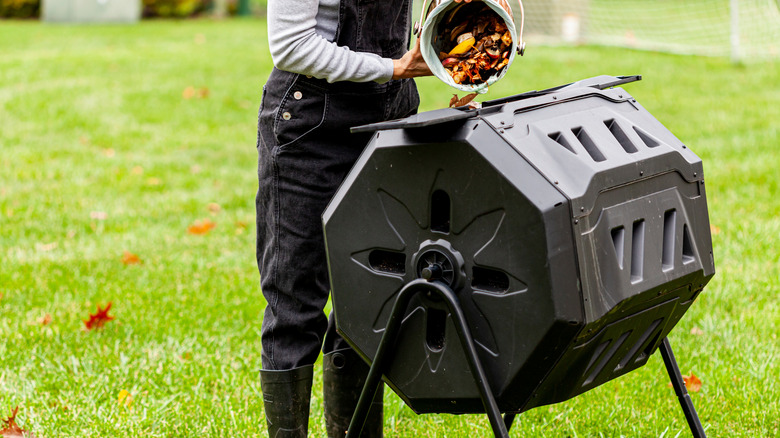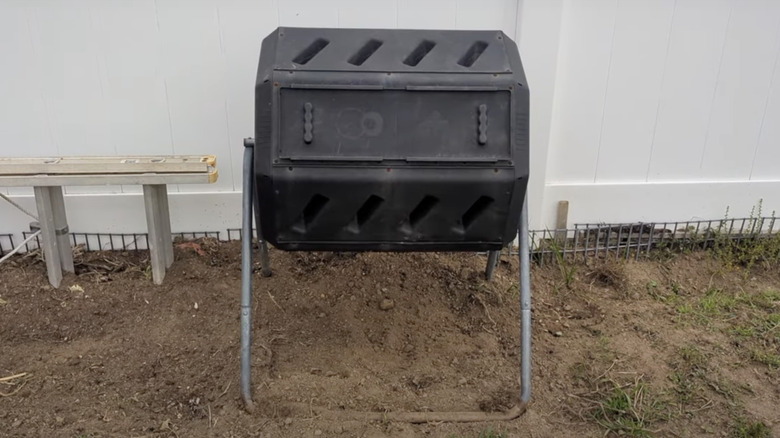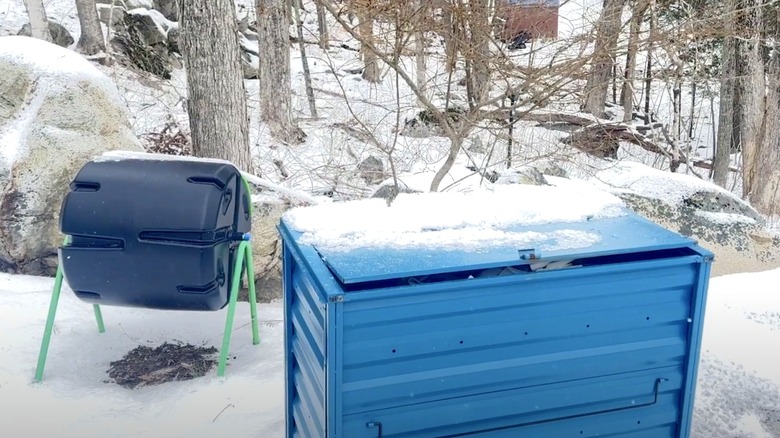Are Tumbling Composters Worth Buying Or Just A Waste Of Money?
You started your first garden not that long ago, and now you've got pulled weeds and table scraps piling up. The increasing green waste has got you contemplating starting a compost. And it's no wonder. Getting free fertilizer and reducing household waste are among the biggest benefits of composting at home, making the practice well worth the effort for most gardeners. The question is, should you invest in a purpose-built tumbling composter (or DIY one, if you're handy) or choose one of the many other composting methods, from simply creating an open pile at the back of your yard to specialist closed fermentation systems like bokashi? The pros of tumbling composters? They're (mostly) easy to turn, have a small footprint, and keep critters out. On the flip side, they can be tricky to fill and empty, don't hold much waste, and can't (really) be used all year.
Tumbling composters generally consist of a plastic (or occasionally metal or resin) barrel fixed to a stand. An axis connected to the stand runs through the center of the barrel so you, the gardener, can turn it to mix and oxygenate the compost. The tumbler will have one or two chambers, each with a door you can slide across or screw off to fill the composer with kitchen scraps and garden waste. Some tumblrs have additional features like aeration holes, chamber filling symbols, cranks, or even motorized turning. Rotating composters are so effective they're even used in large scale settings, from processing palm tree residue in Saudi Arabian plantations to repurposing community food waste.
Why a tumbling composter might be right for you
Forget the outdoor compost bin mistakes that are attracting pests to your yard. There's no way for larger pests, like rodents, to access a tumbling composter. Plus, most tumblers sit well off the ground on steel-legged stands that aren't easily scalable and have tightly fitted doors. This means you can safely add anything — think vegetable peels, meat, and old herbs and spices — to your backyard compost tumbler without fear of attracting vermin. Insects may still get in through perforations, but they help break down the organic material. Small space gardeners rejoice! Tumbling composters boast a relatively small footprint. They make compost just as well when conveniently close to the house, in the corner of a patio or balcony, as they do down the back of the yard.
Most tumbling composters stand waist height or taller and are relatively easy to turn. They may be especially helpful for gardens with bending challenges or who find maneuvering a weighty shovel or pitchfork difficult. Turning is, after all, a vital part of compost making. Turning your compost somewhere between once every 2 weeks to once every 24 hours is optimal for speedy, high-temperature, texturally consistent composting. Make sure you get either a spinning or crank tumbler as they're much easier to turn than their rolling counterpart, which you literally roll around on the ground like a beach ball. Just how fast is fast when it comes to creating usable compost is up for debate: aficionados of rotational composting consider anywhere from 3 weeks to 6 months quick.
Tumbling composter can be hard to fill and aren't winter-proof
You're going to need at least one dual-chamber composter, multiple single chamber tumbling composters, or both a tumbler and a pile. For one, the chambers are relatively small, as are the openings; they don't hold much and you need to load it in by hand. Once a composter is full, it's not the end of the process. The material needs to fully decompose. Then, after all that waiting, you don't get that much compost from a single bin. It reduces by two-thirds in volume once it becomes compost. Estimate or track the volume of food and yard waste your household produces weekly and use that figure to determine the size of tumbler to buy. Look for bins with large openings and lids you can open with one hand.
The small openings make the barrel challenging to empty, too. You may have to get creative — for example laying a tarp down and turning the barrel until all the compost falls onto it. Oh, did we mention that when the bin is more than 75% full, it's heavy, making it hard to turn? While tumbling composters don't take up much space, where you put them needs careful consideration. If they get rained on, they're prone to corrosion and leaking nasty liquids. Live in snowy climes? Unless you have an insulated barrel (which is uncommon), your compost will freeze in the barrel over the winter. Tumblers are a spring through fall composting solution only, and one that's best suited to a partial shade spot in your yard that's protected from the elements.


